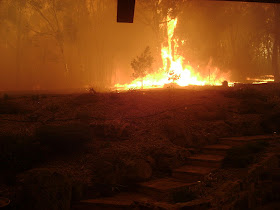* During January and February, widespread heavy rain fell across north-western Queensland, producing extensive flooding around the Mt. Isa and Cloncurry areas. Flood-waters travelled southwards into Lake Eyre over the following weeks.
 The Copperfield River, Queensland, in flood. Photo by Cindy and Damien (click to enlarge)
The Copperfield River, Queensland, in flood. Photo by Cindy and Damien (click to enlarge)* A record-breaking heat- wave began building across south-eastern Australia during January and early February. During this time many temperature records were broken in South Australia, Victoria, Tasmania and southern NSW.
Tasmania recorded its highest ever temperature on 30th January (Scamander 42.2C).
On 7th February Victoria’s highest ever temperature was registered at Hopetoun at 48.8C and Melbourne’s new temperature record was raised to 46.4C on the same day.
Numerous deaths attributed to the heat were reported and morgues in Melbourne and Adelaide were filled to capacity because of the spike in heat related deaths. In Melbourne alone it’s estimated that more that 350 people died as a direct result of the heat during the scorching days of the 28th, 29th and 30th January, when maximum temperatures climbed above 43C on each day.
* Disastrous bushfires erupted across parts of central Victoria on Saturday 7th February – the Black Saturday fires - with 173 lives lost and more than 1800 houses razed. These were the worst fires in Australian history.

Black Saturday fires rage across Victoria. Photograph from Wikipedia Commons. (Daniel Cleavely)
(Click to enlarge)
* An east coast low dumped heavy rain along the NSW coastal areas between Kempsey and Newcastle on Tuesday 17th February, generating further floods across the already saturated Bellinger River catchment. The town of Bellingen was totally isolated over the next 24-hour period.
* On Tuesday March 31st, phenomenal rain from a nest of slow moving thunderstorms produced major flooding around Coffs Harbour. Some locations experienced more than 400 mm in a six hour period. The flooding produced major damage as well as numerous evacuations around the area.

Raging floods in Coffs Harbour. Photo by Steve Canute
* Heavy snow fell across the NSW and Victorian ski fields during Sunday 26th and Monday 27th April, allowing Mount Buller in Victoria, to open for business on Saturday 2nd May – the earliest start to the ski season in 45 years.
* Heavy rain set in across south-eastern Queensland on the night of Tuesday 19th May and continued through Wednesday. 48 hour totals in excess of 300 mm produced massive flooding across Brisbane and the Gold Coast with the inundation being compared in extent to the floods of 1974. Massive infrastructure damage unfolded with roads cut, power-lines down and waterways overtopping their banks. South-eastern Queensland was declared a natural disaster area by the Premier as the damage bill continued to rise. Queensland dams rose to 73 % by the end of the week – an increase in 13% in less than 1 week.
* The eastern rainfall focus then turned to the northern coastal areas of NSW on Thursday and Friday 21st and 22nd May with very heavy falls triggering widespread flooding across the NSW Northern Rivers and Mid North coast. Flood warnings eventually spread to 10 major river systems in the area.
* On Monday 15th June, rain began ramping up along the NSW coastline, in particular the Mid North Coast and northern Rivers areas. A succession of wet days followed with three day totals in excess of 200 mm accumulating in some areas, and a minor flood warning was issued on Saturday 10th for the Orara River – a tributary of the Clarence River.
* Heavy rainfall across eastern Tasmania, produced by a low over eastern Victoria, generated big rain gauge totals during Wednesday and Thursday, 12th and 13th August, with substantial flooding resulting over the South Esk and Macquarie River basins.
* Very warm to hot weather developed over central and eastern Australia during the week of 9th to 16th August, in north-westerly winds ahead of the fronts, as they moved eastward. Alice Springs experienced 6 days in a row where the temperature reached or exceeded 30C, which is the first time this has happened in August in at least 60 years.
* On Tuesday 22nd September a major dust storm spread across inland NSW, affecting Broken Hill, Tibooburra, and the ACT. The dust hit Sydney early on Wed 23rd, producing the most intense dust storm across the city in living memory. The dust then extended north over the next 48 hours, affecting Brisbane and then cities further north over inland and coastal areas of Queensland.

Red dust blankets Sydney on Wednesday 23rd September.
Image from Wikipedia Commons
(Merbabu)
(Click to enlarge)
* Heavy rain over the Mid North Coast area during Monday 26th October produced further minor to moderate flooding in the Bellinger, Nambucca and Orara river valleys during Tuesday 27th and Wednesday 28th October. This was the fourth time that the area has flooded in the last 9 months and the districts were declared a natural disaster area later in the week.
* Tropical Cyclone “Laurence” formed off the Kimberley coastline on Sunday 13th December, and after an irregular movement, proceeded to track across the central inland of Australia. The remnants of “Laurence” then produced widespread flooding rains across large areas of NSW and southern Queensland during the last week of 2009.
No comments:
Post a Comment